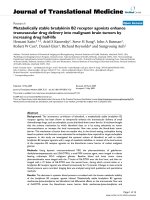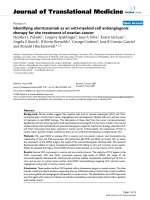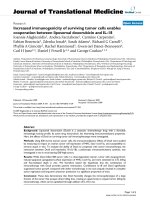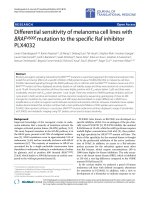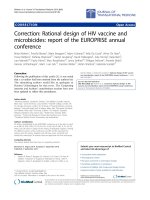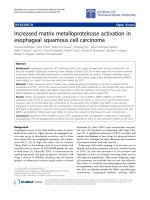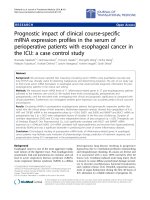báo cáo hóa học: " Increased interleukin-1beta levels following low dose MDMA induces tolerance against the 5-HT neurotoxicity produced by challenge MDMA." doc
Bạn đang xem bản rút gọn của tài liệu. Xem và tải ngay bản đầy đủ của tài liệu tại đây (957.31 KB, 35 trang )
This Provisional PDF corresponds to the article as it appeared upon acceptance. Fully formatted
PDF and full text (HTML) versions will be made available soon.
Increased interleukin-1beta levels following low dose MDMA induces tolerance
against the 5-HT neurotoxicity produced by challenge MDMA.
Journal of Neuroinflammation 2011, 8:165 doi:10.1186/1742-2094-8-165
Andrea Mayado ()
Elisa Torres ()
Maria D Gutierrez-Lopez ()
Maria I Colado ()
Esther O'Shea ()
ISSN 1742-2094
Article type Research
Submission date 20 September 2011
Acceptance date 24 November 2011
Publication date 24 November 2011
Article URL />This peer-reviewed article was published immediately upon acceptance. It can be downloaded,
printed and distributed freely for any purposes (see copyright notice below).
Articles in JNI are listed in PubMed and archived at PubMed Central.
For information about publishing your research in JNI or any BioMed Central journal, go to
/>For information about other BioMed Central publications go to
/>Journal of Neuroinflammation
© 2011 Mayado et al. ; licensee BioMed Central Ltd.
This is an open access article distributed under the terms of the Creative Commons Attribution License ( />which permits unrestricted use, distribution, and reproduction in any medium, provided the original work is properly cited.
Increased interleukin-1β levels following low dose MDMA induces
tolerance against the 5-HT neurotoxicity produced by challenge
MDMA.
Andrea Mayado, Elisa Torres, Maria D Gutierrez-Lopez, Maria I Colado,
Esther
O’Shea
Departamento de Farmacologia, Facultad de Medicina, Universidad Complutense,
Madrid, Spain
Author for correspondence, E. O’Shea, Departamento de Farmacologia, Facultad de
Medicina, Universidad Complutense, Madrid 28040, Spain. Phone: +34-91-3947264.
Fax: +34-91-3941464. E-mail:
Abstract
Background. Preconditioning is a phenomenon by which tolerance develops to injury
by previous exposure to a stressor of mild severity. Previous studies have shown that
single or repeated low dose MDMA can attenuate 5-HT transporter loss produced by a
subsequent neurotoxic dose of the drug. We have explored the mechanism of delayed
preconditioning by low dose MDMA.
Methods. Male Dark Agouti rats were given low dose MDMA (3 mg/kg, i.p.) 96 h
before receiving neurotoxic MDMA (12.5 mg/kg, i.p.). IL-1β and IL1ra levels and 5-HT
transporter density in frontal cortex were quantified at 1 h, 3 h or 7 days. IL-1β, IL-1ra
and IL-1RI were determined between 3 h and 96 h after low dose MDMA. sIL-1RI
combined with low dose MDMA or IL-1β were given 96 h before neurotoxic MDMA
and toxicity assessed 7 days later.
Results. Pretreatment with low dose MDMA attenuated both the 5-HT transporter loss
and elevated IL-1β levels induced by neurotoxic MDMA while producing an increase in
IL-1ra levels. Low dose MDMA produced an increase in IL-1β at 3 h and in IL-1ra at
96 h. sIL-1RI expression was also increased after low dose MDMA. Coadministration
of sIL-1RI (3 µg, i.c.v.) prevented the protection against neurotoxic MDMA provided
by low dose MDMA. Furthermore, IL-1β (2.5 pg, intracortical) given 96 h before
neurotoxic MDMA protected against the 5-HT neurotoxicity produced by the drug, thus
mimicking preconditioning.
Conclusions. These results suggest that IL-1β plays an important role in the
development of delayed preconditioning by low dose MDMA.
Keywords: MDMA, preconditioning, tolerance, IL-1β, IL-1ra, sIL-1RI, neurotoxicity,
5-HT.
Background
3,4- Methylenedioxymethamphetamine (MDMA or “ecstasy”), an amphetamine
derivative, is a popular drug of abuse among young people. In experimental animals,
MDMA produces a series of immediate neurochemical, biochemical and behavioural
effects as well as producing long–term species-specific neurotoxicity [1]. In rats,
MDMA produces an apparent loss of 5-HT nerve terminals [2, 3] demonstrated by
immunohistochemical techniques and biochemically the damage is reflected by a
substantial decrease in the concentration of 5-HT and its metabolite, 5-
hydroxyindolacetic acid (5-HIAA) [4,5] and a reduction in the density of 5-HT uptake
sites labelled with [
3
H]-paroxetine [4,6,7]. MDMA produces a hyperthermic response
immediately after injection which lasts at least 5-6 h and appears to modulate the long-
term neuronal damaged caused by the drug [8,9]. MDMA also produces a
neuroinflammatory response characterised by an increase in mature IL-1β and of its
precursor protein (pro-IL-1β) in rat frontal cortex as well as microglial activation [9,10].
When exposed to practically any stimulus capable of causing injury at a level close to
(but below) the threshold of damage, most living organisms respond with protective
mechanisms to potentially recurring challenges. Janoff introduced the term
“preconditioning” for this phenomenon [11]. The preconditioning phenomenon has
been observed in different tissues and organs including the brain, and in different
models of injury. Pre-exposure to heat shock treatment, mild ischemia or hypoxia
induces tolerance against a subsequent neurotoxic insult in rodents [12-16]. The
development of preconditioning may involve a number of different effectors including
the activation of cellular defence mechanisms such as antioxidant systems, heat shock
proteins and cell death/survival determinants, or responses at tissue level for example
reduced inflammatory responsiveness [17]. In line with this ischemic tolerance has been
shown to involve IL-1β and IL-1ra [12, 18, 19]. Repeated exposure to heat shock offers
protection against MDMA-induced 5-HT neurotoxicity in Dark Agouti rats [13] and
more recently it has been established that prior exposure of adult rats to MDMA
provides protection against a subsequent MDMA-induced 5-HT depletion in the brain
[20, 21]. The neuroprotection exerted is independent of the ambient temperature at
which the low dose MDMA is given [21] and does not appear to involve the
hyperthermic response, alterations in brain MDMA pharmacokinetics or changes in 5-
HT transporter activity [20, 21, unpublished observations].
IL-1β is often described as the prototypical pro-inflammatory cytokine. Released in
response to local or systemic injury or disease, IL-1β orchestrates host defence
response. It is a potent pyrogen [22] and a key mediator of innate and adaptive immune
response [23]. IL-1β exerts its action by binding of IL-1 type I receptor (IL-1RI),
forming a complex which then binds to the IL-1R accessory protein (IL-1RAcP),
resulting in the initiation of signal transduction [24]. IL-1 receptor antagonist (IL-1ra) is
a competitive antagonist of IL-1RI that selectively binds, but fails to trigger receptor
association with the accessory protein resulting in the blockade of all known actions of
IL-1. The extracellular domain of IL-1RI may also be proteolytically cleaved from the
cell surface giving rise to IL-1 soluble type I receptor (IL-1sRI) [25]. This soluble form
of the receptor binds both IL-1β and IL-1ra but does not initiate signal transduction.
The aims of this study were: 1) to describe MDMA preconditioning (interval, number of
doses), 2) to examine the time-course of low dose MDMA-induced changes in IL-1β,
IL-1ra levels and soluble and membrane bound IL-1RI expression in rat frontal cortex,
3) to study the effect of exogenously administered sIL-1RI on the protection induced by
MDMA pre-treatment against subsequent neurotoxic MDMA, and 4) to analyse the
effect of exogenously administered IL-1β against subsequent neurotoxic MDMA.
We have demonstrated that low dose MDMA can provide long-lasting neuroprotection
against a subsequent challenge of higher dose MDMA and that the preconditioning
appears to involve low dose MDMA-induced IL-1β release.
Methods
Animals, drugs and reagents
Male Dark Agouti rats (175-200 g, Harlan Laboratories Models, Barcelona) were used.
MDMA induces a reproducible acute hyperthermic response in this strain [5, 26] and
also a reproducible long-term neurotoxic loss of 5-HT terminals after a single dose [5].
Rats were housed in groups of 5 in conditions of constant temperature (21 ºC ± 2 ºC)
and a 12 h light/dark cycle (lights on: 08 h 00 min) and given free access to food and
water. Low dose MDMA (3 mg/kg, i.p.) was given once or repeatedly (1 injection daily
for 4 days) to rats and 24 h, 96 h or 7 days later animals received neurotoxic MDMA
(12.5 mg/kg, i.p.). Room temperature at the time of MDMA administration was 21-22
ºC. To determine neurotoxicity, [
3
H]-paroxetine-labelled 5-HT transporter density was
measured in frontal cortex 7 days after neurotoxic MDMA. To determine IL-1β and IL-
1ra levels and IL-1RI expression, animals were killed 3 h, 6 h, 24 h or 96 h after
MDMA (3 mg/kg, i.p.) or 1 h or 3 h after receiving neurotoxic MDMA.
MDMA hydrochloride (LIPOMED, Arlesheim, Suiza) was dissolved in saline (0.9 %
NaCl) and given in a volume of 1 mL/kg. The dose is reported in terms of the base.
Control animals were injected with saline.
For intracerebroventricular (i.c.v.) and intracortical administrations rats were
anesthetized with a mixture of isoflurane (3.5 % for induction, 1-2 % for maintenance;
flow rate 1.5 L min
-1
) and nitrous oxide/oxygen mixture (30/70 %) in air and placed in a
stereotaxic frame secured in a Kopf stereotaxic frame with the tooth bar 3.3 mm below
interaural zero. A 22 G guide cannula was implanted in the right lateral ventricle or
frontal cortex (according to the following coordinates: for ventricle: 7.9 mm rostral to
the interaural line, 0.8 mm lateral to the midline and 3.1 mm below the skull surface;
and for cortex: 8.9 mm rostral to the interaural line, 0.4 mm lateral to the midline and
2.1 mm below the skull surface [27]. The cannula was secured to the skull as described
by Baldwin et al. [28]. Injections took place 5 days after surgery through a 28 G injector
(Plastics One, Roanoke, VA, USA) which fitted in and protruded 1 mm beyond the
guide cannula.
Soluble interleukin-1 receptor type I (sIL-1RI; Sigma-Aldrich, Madrid, Spain) and
recombinant rat IL-1β (R&D Systems, Minneapolis, MN, USA) were dissolved in
phosphate-buffered saline (PBS) containing 0.1 % bovine serum albumin (BSA). sIL-
1RI (3 µg in 5 µL of PBS over 5 min; i.c.v.) was administered 5 min before and 3 h
after low dose MDMA. IL-1β (2.5 pg in 5 µL over 5 min; intracortical) was
administered 96 h before neurotoxic MDMA.
All experimental procedures were performed in accordance with the guidelines of the
Animal Welfare Committee of the Universidad Complutense de Madrid (following
European Council Directives 86/609/CEE and 2003/65/CE).
Measurement of rectal temperature
Immediately before and up to 6 h after MDMA injection, temperature was measured by
use of a digital readout thermocouple (BAT12 thermometer, Physitemp, NJ, USA) with
a resolution of 0.1 ºC and accuracy of ± 0.1 ºC attached to a RET-2 Rodent Sensor
which was inserted 2.5 cm into the rectum of the rat, the animal being lightly restrained
by holding it in the hand. A steady readout was obtained within 10 s of probe insertion.
Western blot for IL-1RI immunoreactivity
Expression of IL-1RI was determined in the soluble and membrane fractions of frontal
cortex by Western blot. Preparation of soluble and membrane fractions was carried out
by modification of the method described by Wang et al. [29]. Tissue was homogenized
by sonication in ice-cold buffer contain 50 mM Tris, 320 mM sucrose and a number of
phosphatase and protease inhibitors (0.2 M phenylmethanesulphonylfluoride, 0.5 M
NaVO
4
, 1 M NaMoO
4
and Complete Mini, Roche, Spain). Samples were centrifuged at
100 000 x g for 60 min at 4 ºC and protein determined in the supernatant [30]. This was
the fraction containing the soluble form of IL-1RI. The pellet was resuspended in the
same buffer by sonication. The homogenate was centrifuged 12 000 x g for 20 min at 4
ºC and protein determined in the supernatant [30]. This was the fraction containing the
membrane bound form of IL-1RI.
The samples were boiled in Laemmli buffer and aliquots containing 100 µg of protein
were separated by 10 % SDS-polyacrylamide gel electrophoresis (SDS-PAGE) and
transferred to nitrocellulose membranes. Nonspecific sites were blocked by incubation
for 1 h in TBS containing 5 % skimmed milk. Membranes were incubated overnight at
4 ºC with monoclonal rabbit anti IL-1RI (Abcam, UK; 1:1000) as primary antibody
followed by incubation with anti-rabbit IgG-horseradish peroxidase (GE Healthcare,
Spain; 1:2000) for 2 h. Equal protein sample loading was confirmed by quantification of
the β-actin signal.
Immunoreactivity was detected with an enhanced chemiluminescence Western blot
detection system (GE Healthcare) followed by exposure to Amersham Hyperfilm ECL
(GE Healthcare) for 1-10 min. Different film exposure times were used to ensure that
band were not saturated. Quantification of specific bands on the film was performed
using the Quantity One program (BioRad Laboratories, Inc, CA, USA). Each IL-1RI
band density was normalised for protein content by referring it to its β-actin band
density and then the IL-1RI expression in the different experimental conditions was
expressed as a percentage of the control group.
IL-1β and IL-1ra immunoassays
Brain levels of IL-1β and IL-1ra were determined in frontal cortex using commercially
available sandwich enzyme-linked immunosorbent assays (ELISA) (Rat IL-1β/IL-1F2
and Human IL-1ra/IL-1F3 Quantikine ELISA Kits, respectively; R&D Systems,
Minneapolis, MN, USA). According to the manufacturer, the IL-1β kit provides a valid
measure of the levels of mature 17 kDa IL-1β (the limit of sensitivity was 5 pg/mL) but
underestimates the precursor form 31 kDa IL-1β (non-biologically active). Samples
were prepared by homogenization in 5 volumes of ice-cold buffer (50 mM Tris, 320
mM sucrose, 1 mM dithiothreitol, 10 µg/mL leupeptin, 2 µg/mL aprotinin and 0.2 %
phenantroline; pH 7.0). Samples were centrifuged at 14 000 x g for 20 min at 4 ºC.
Protein was determined in the supernatant [30]. Samples were assayed in triplicate
following the manufacturer’s guidelines. Quantification was performed using a standard
curve of increasing concentrations of IL-1β or IL-1ra. The optical density of each well
was determined using a microplate reader (ELX808 IU, Ultra Microplate Reader, Bio-
Tek Instruments, VT, USA) set to 450 nm (correction wavelength set at 540 nm). Intra-
assay and inter-assay variations were less than 5 % and 15 %, respectively, for both kits.
Quantification of 5-HT transporter density by [
3
H]-paroxetine binding
[
3
H]-Paroxetine binding was measured by the method described in detail by Hewitt and
Green [6]. Briefly, frontal cortex from individual animals was homogenized in ice-cold
Tris-HCl (50 mM; pH 7.4) containing NaCl (120 mM) and KCl (5 mM) using an Ultra-
Turrax. The homogenate was centrifuged at 30 000 x g for 10 min at 4 ºC. The
supernatant was discarded and the wash procedure repeated twice more. The pellet was
finally resuspended in the Tris buffer at a concentration of 10 mg tissue/mL. Aliquots of
tissue (800 µL) were incubated with a saturating concentration of [
3
H]-paroxetine (1nM,
specific activity = 21.4 Ci/mmol, Perkin-Elmer, Spain) for 90 min at room temperature
in the absence and presence of 5-HT (100 µM) for determination of total and non-
specific binding, respectively. Assays were terminated by rapid filtration through glass
fibre filters and radioactivity determined by scintillation spectrometry. Protein was
determined by the method of Lowry et al. [31].
Statistics
Data from ELISA, immunoreactivity and 5-HT transporter studies were analyzed using
one-way ANOVA followed by Newman-Keuls multiple-comparisons test when a
significant F value was obtained. Statistical analyses of temperature measurements were
performed by two-way ANOVA with repeated measures using treatment as the between
subjects factor and time as the repeated measure, followed by Bonferroni as post-test
(GraphPad Prism 5; GraphPad Software Inc., San Diego, CA, USA).
Results
Effect of pretreatment with low dose MDMA against MDMA-induced loss of 5-HT
uptake sites in frontal cortex
To study the effect of pretreatment with low dose MDMA on the loss of 5-HT uptake
sites (5-HTT) produced by a neurotoxic dose of MDMA, rats were treated with a daily
dose of MDMA (3 mg/kg, i.p.) for 4 consecutive days and given MDMA (12.5 mg/kg,
i.p.) 24 h after the final dose. Separate groups of animals were given a single MDMA (3
mg/kg, i.p.) injection 24 h, 96 h or 7 days before MDMA (12.5 mg/kg, i.p.)
administration.
Pretreatment with repeated low dose MDMA attenuated the decrease in 5-HTT density
induced by a subsequent neurotoxic dose of MDMA in the frontal cortex (58 %
protection) but did not modify the density of 5-HT uptakes sites in saline treated-
animals (Fig. 1A). Administration of a single low dose MDMA injection 24 h or 96 h
before neurotoxic MDMA also prevented the loss of 5-HTT (Fig. 1B). The level of
protection was similar to that observed following repeated doses and similar for both
intervals (71-72 %), however, when low dose MDMA was given 7 days before
neurotoxic MDMA, the protection provided was less marked (42 %; Fig.1B).
Effect of pretreatment with low dose MDMA on neurotoxic MDMA-induced
hyperthermia
Two-way ANOVA indicated that there was a significant effect of treatment (F
3,20
=
104.4, P<0.0001), time (F
9,180
= 87.0, P<0.0001) and interaction (F
27,180
=9.48,
P<0.0001). Bonferroni post test revealed that MDMA (12.5 mg/kg, i.p.) produced a
hyperthermic response which peaked 60 min after treatment and was sustained for up to
6 h after treatment. Pretreatment with a single low dose of MDMA (3 mg/kg, i.p.) 96 h
earlier did not affect the hyperthermia of neurotoxic MDMA or the rectal temperature of
saline-treated animals (Fig. 1C).
Since a single low dose of MDMA administered 96 h before neurotoxic MDMA
provided extensive delayed neuroprotection this protocol was used for further studies.
Effect of pretreatment with low dose MDMA on neurotoxic MDMA-induced
changes in IL-1β and IL-1ra levels in frontal cortex
Administration of neurotoxic MDMA (12.5 mg/kg, i.p.) produced an increase in IL-1β
levels in frontal cortex 3 h after injection as previously described [9, 32]. Pretreatment
with a single low dose of MDMA (3 mg/kg, i.p.) 96 h before giving the neurotoxic dose
attenuated this increase in IL-1β (Fig. 2A).
Neurotoxic MDMA did not modify IL-1ra levels in frontal cortex as described
previously [33], however pretreatment with low dose MDMA produced an increase in
IL-1ra levels 1 h after the neurotoxic dose (Fig 2B).
Effect of low dose MDMA on IL-1β and IL-1ra levels in frontal cortex
For the examination of IL-1β and IL-1ra levels following low dose MDMA, animals
were killed 3 h, 6 h, 24 h and 96 h after an injection of MDMA 3 mg/kg. Administration
of a single low dose of MDMA produced an increase in IL-1β levels in the frontal
cortex 3 h after injection compared with the saline-treated control group (Fig. 3A).
However, no changes in levels were observed 6 h, 24 h or 96 h after injection.
A single low dose of MDMA produced an increase in IL-1ra levels in the frontal cortex
96 h after administration without producing significant changes in the levels at earlier
time points (Fig. 3B).
Effect of low dose MDMA on IL-1 receptor type I (IL-1RI) expression in frontal
cortex
IL-1RI expression in the membrane and soluble fractions of frontal cortex was
measured 3 h, 6 h, 24 h and 96 h after low dose MDMA administration.
MDMA did not alter IL-1RI expression in the membrane fraction at any of the time-
points examined (Fig. 3C). However, in the soluble fraction a biphasic response was
observed. IL-1RI expression increased 3 h and 6 h after MDMA, returned to control
levels at 24 h and rose again at 96 h (Fig. 3D).
Effect of sIL-1RI on the protection provided by low dose MDMA against
neurotoxic MDMA
MDMA (12.5 mg/kg, i.p.) produced a decrease in the density of 5-HTT in both ipsi- and
contralateral frontal cortex 7 days after treatment. This 5-HTT loss was attenuated by
pretreatment with MDMA (3 mg/kg, i.p.) given 96 h before the neurotoxic dose (Fig.
4A, B). Injection of sIL-1RI (3 µg per animal, i.c.v.) 5 min before and 3 h after low dose
MDMA prevented the neuroprotection exerted by the pretreatment in the ipsilateral
cortex (Fig. 4A) but failed to modify it in the contralateral side (Fig. 4B). sIL-1RI
administration alone did not alter MDMA neurotoxicity in the frontal cortex [33] or
modify the density of 5-HTT in saline-treated controls (Fig. 4A, B). Furthermore, the
administration of sIL-1RI did not alter neurotoxic MDMA-induced hyperthermia (data
not shown).
Effect of pretreatment with IL-1β on the 5-HTT loss induced by neurotoxic
MDMA
In order to avoid any dilution of the effects by the use of tissue which had not been
reached the IL- β injection, only tissue around the injection site was used in this assay.
Tissue was obtained 2 mm rostral to and caudal from the injection site using a rat brain
matrix.
As described above, MDMA (12.5 mg/kg, i.p.) produced a significant reduction in the
density of 5-HTT in the ipsi- and contralateral sides of the frontal cortex 7 days later
(Fig. 5A, B). Injection of IL-1β (2.5 pg, intracortical) 96 h before administration of
neurotoxic MDMA (12.5 mg/kg, i.p.) attenuated the reduction in the density of [
3
H]-
paroxetine-labelled 5-HT uptake sites (Fig. 5A). In the contralateral cortex, IL-1β
pretreatment did not attenuate the decrease in the density of 5-HT uptake sites induced
by neurotoxic MDMA (Fig. 5B).
Discussion
Preconditioning, a phenomenon by which exposure to a non-harmful stimulus confers
tolerance to subsequent exposure to a more intense stimulus of the same or of a different
nature, has been described in many different tissues and organs following exposure to a
diverse range of stimuli [17, 34]. We have previously described a model of “cross-
tolerance” in which heat-shock pretreatment protects against the 5-HT neurotoxicity
induced by MDMA [13] and more recently low dose MDMA-induced tolerance has
been described [20, 21]. The present results indicate an important role for interleukin-
1beta (IL-1β) in the development of this low dose MDMA-induced tolerance against the
5-HT neurotoxicity induced by a higher subsequent dose of the drug.
In the present study we observed that the protection produced by low dose MDMA is
not dependent on the number of doses applied since a single dose of MDMA 3 mg/kg
protects to a similar extent as 4 consecutive administrations against the toxicity of
neurotoxic MDMA given 24 h later. The protection provided by a single low dose of
MDMA is long-lasting being observed when the pretreatment is given 24 h and 96 h
earlier and continuing to provide partial protection when given up to 7 days before the
higher dose of MDMA. The results agree with those of Piper et al [35, 36] who
described protection against binge MDMA-induced 5-HT neurotoxicity 7 days
following chronic exposure to low doses of the drug in both adolescent and adult rats
but differ from those described by Bhide et al [20] where tolerance against a binge
dosing regimen of 10 mg/kg
every 2 h for 4 doses was relatively transient in nature and
lost when the window was extended to 4 days. The time-scale of neuroprotection
observed indicates that the processes involved in its development might involve the
synthesis of new proteins which could provide a wide window for protection. Studies in
other lesion models in which tolerance can be induced by exposure to a less intense
stimulus have revealed two windows in which tolerance develops. The first is a rapid
tolerance which is observed minutes after the trigger and lasts for hours involving
factors such as K
ATP
channels, nitric oxide, adenosine and protein kinase alpha/delta
[34]. A second window of protection, delayed tolerance, develops over hours and days,
and usually involves de novo protein synthesis. Most inducers of tolerance can produce
both rapid and delayed tolerance. The protection observed in this study can be described
as delayed tolerance since it develops hours after the initial insult [34]. Whether or not
low dose MDMA can also produce rapid tolerance is unknown. A low dose of MDMA
followed by a neurotoxic dose within minutes or hours would, in all likelihood, produce
a potentiated hyperthermic reaction much as is observed following the administration of
low dose MDMA in binge protocols where the rectal temperature increases following
each subsequent dose separated by 3 h [37]. This would result in increased
neurotoxicity [38]. Separation of the low and high dose MDMA by 96 h resulted in no
change in the hyperthermic response of neurotoxic MDMA and a similar lack of effect
was observed with a 24 h interval [21]. This allows us to rule out changes in the
hyperthermic reaction as a factor involved in the neuroprotection observed as previously
described [20, 21].
At doses that produce neurotoxicity, MDMA produces a neuroinflammatory reaction
characterised by an increase in IL-1β levels and microglial activation in the frontal
cortex [9, 10, 32, 33, 39]. A single low dose of MDMA given 96 h earlier reduces the
elevation in IL-1β levels induced by neurotoxic MDMA. Although the participation of
IL-1β in MDMA-induced neurotoxicity has not been thoroughly established, it appears
it may play at least a partial role in its development since compounds which reduce IL-
1β release and microglial activation following MDMA partially protect against 5-HT
neurotoxicity [32, 39].
The suppression of the increase in IL-1β levels following neurotoxic MDMA is
accompanied by an increase in IL-1ra levels in the frontal cortex, an effect not observed
following neurotoxic MDMA given alone [33; present results]. This increase in IL-1ra
levels is due to the pretreatment with low dose MDMA rather than to an interaction
between the two treatments since the increase is also observed 96 h after the
pretreatment. IL-1ra, the endogenous antagonist of IL-1β, which may be released as a
consequence of large increases in IL-1β levels, binds to the IL-1RI with high affinity
and inhibits IL-1β signal transduction thus providing a mechanism for limiting IL-1β
mediated responses [40]. In fact, IL-1ra has been shown to protect in several models of
brain injury including ischemic, excitotoxic and traumatic brain insults [41-44]. The
role of this antagonist in protection is further supported by studies in which inhibition or
deletion of endogenous IL-1ra enhances ischemic brain injury [45] and increases
inflammatory responses [46]. In addition, endogenous IL-1ra has been implicated in the
neuroprotective effects of cannabinoids [47] and we have demonstrated that a CB2
agonist provides partial protection against the neurotoxic effects of MDMA [32]. Thus,
this increase in IL-1ra levels following neurotoxic MDMA in pretreated animals may
contribute to the tolerance observed. In fact it is thought that the relative production of
IL-1ra or IL-1β in response to either mild or severe ischemia appears to be quite
important in determining outcome [48]. Although IL-1ra may be involved in the
expression of tolerance since low dose MDMA pretreatment increases its levels
following challenge with neurotoxic MDMA, it is not clear that it is the triggering factor
since levels of the antagonist are unaltered at early time points increasing only 96 h after
the dose of MDMA. Furthermore, it is not increased 24 h after low dose MDMA, a
protocol that also provided neuroprotection.
Low dose MDMA did, however, increase IL-1β levels at an early time point (3 h) and
produce changes in the expression of the IL-1 type I receptor. The IL-1R has high
affinity for both IL-1β and its antagonist, IL-1ra. Following the action of various
proteases, the receptor is cleaved from the membrane and released into the extracellular
space. At early time points (3 h and 6 h after low dose MDMA administration) there is
an increase in the expression of the receptor in the soluble fraction. The expression
normalises at 24 h and increases again at 96 h. Expression of the receptor in the
membrane fraction was unaltered at all time points, thus the overall increase may
possibly indicate synthesis of the receptor. The expression of the receptor in the soluble
fraction represents levels of the proteolytic cleaved extracellular domains of the
membrane-bound receptor. This released or soluble form of the receptor, sIL-1RI, binds
IL-1β but mediates no signal transduction [25]. Thus, sIL-1RI acts a soluble-decoy
receptor for IL-1β, inhibiting the actions of IL-1β at the membrane bound form of IL-
1RI. Alongside IL-1ra it attenuates the effects of IL-1β and potentially protects against
the deleterious effects of excessive release of the cytokine [49]. Thus, the increase in the
soluble form of the receptor 96 h after low dose MDMA in conjunction with the
increase in levels of the antagonist may lead to a reduction in the consequences of the
elevation of IL-1β levels induced by neurotoxic MDMA. However, similar to IL-1ra,
the possible role of this receptor in the tolerance observed is not clear since expression
of the soluble form of the receptor is not increased 24 h after low dose MDMA, time at
which neuroprotection is observed.
In order to explore the role of IL-1β as a trigger of preconditioning, sIL-1RI was given
with the preconditioning dose of MDMA, 96 h before neurotoxic MDMA. This
treatment attenuated the protective effect of the low dose MDMA in the ipsilateral side
of the frontal cortex having no effect in the contralateral side. Although the soluble
receptor also has affinity for IL-1ra [49], the increase in IL-1β levels in the frontal
cortex following low dose MDMA and the lack of modification of IL-1ra levels at the
same early time points may shift the balance of binding towards the cytokine and away
from the antagonist. Therefore, these results suggest a role for IL-1β in the development
of tolerance and are supported by studies which describe an important role for NF-κB in
ischemic tolerance [50].
Interestingly, the administration of IL-1β directly into the cortex mimicked the
preconditioning effect of low dose MDMA. The infusion of the cytokine in the frontal
cortex 96 h before neurotoxic MDMA prevented the loss of 5-HT transporter observed
after the drug, providing further support for a role of IL-1β in the development of
delayed tolerance. Similar preconditioning effects have been observed in other models
of damage. Thus, administration of the cytokine directly into the brain induced ischemic
tolerance in gerbils [51].
Conclusions
Low dose MDMA produces delayed preconditioning in rats. The tolerance against
neurotoxic MDMA-induced 5-HT transporter loss involves IL-1β. Additional studies
are required to identify the role of mediators further downstream in IL-1β induced
tolerance against MDMA-induced neurotoxicity.
Abbreviations: 5-HIAA, 5-hydroxyindoleacetic acid; 5-HT, 5-hydroxytryptamine;
BSA, bovine serum albumin; IL-1β, interleukin-1beta; IL-1ra, IL-1 receptor antagonist;
IL-1RI, IL-1 receptor type I; MDMA, 3,4-methylenedioxymethamphetamine; PBS,
phosphate-buffered saline; sIL-1RI, soluble IL-1 receptor type I.
Competing interests
The authors declare that they have no competing interests.
Authors’ contributions
AM carried out the neurotoxicity studies, immunoassays and Western blot studies and
participated in the interpretation of the data, ET participated in the neurotoxicity studies,
MDGL participated in the coordination of the study and statistical analysis, MIC
participated in the interpretation of the data and helped draft the manuscript, EOS
participated in the design and coordination of the study, in the interpretation of the data
and in the drafting of the manuscript. All authors read and approved the final
manuscript.
Acknowledgements
This work was supported by MICINN (Grant nos. PI07/0892, SAF2010-21529 and
RETICS RD06/0001/0006), Plan Nacional sobre Drogas (Grant no. PR61/08-16410),
UCM (Grant nos. CCG08-UCM/SAL-4232 and 910258). The authors ET and AM
received predoctoral funding from Ministerio de Ciencia e Innovación and Ministerio de
Educación, Spain, respectively.
References
1. Green AR, Mechan AO, Elliott JM, O’Shea E, Colado MI: The pharmacology and
clinical pharmacology of 3,4-methylenedioxymethamphetamine (MDMA,
"ecstasy"). Pharmacol Rev 2003, 55: 463-508.
2. Commins DL, Vosmer G, Virus RM, Woolverton WL, Schuster CR, Seiden LS:
Biochemical and histological evidence that methylenedioxymethylamphetamine
(MDMA) is toxic to neurons in the rat brain. J Pharmacol Exp Ther 1987, 241:
338-345.
3. O’Hearn E, Battaglia G, De Souza EB, Kuhar MJ, Molliver ME:
Methylenedioxyamphetamine (MDA) and methylenedioxymethamphetamine
(MDMA) cause selective ablation of serotonergic axon terminals in forebrain:
immunocytochemical evidence for neurotoxicity. J Neurosci 1988, 8: 2788-2803.
4. Colado MI, O’Shea E, Granados R, Murray TK, Green AR: In vivo evidence for
free radical involvement in the degeneration of rat brain 5-HT following
administration of MDMA ('ecstasy') and p-chloroamphetamine but not the
degeneration following fenfluramine. Br J Pharmacol 1997, 121: 889-900.
5. O’Shea E, Granados R, Esteban B, Colado MI, Green AR: The relationship
between the degree of neurodegeneration of rat brain 5-HT nerve terminals
and the dose and frequency of administration of MDMA ('ecstasy').
Neuropharmacology 1998, 37: 919-926.
6. Hewitt KE, Green AR: Chlormethiazole, dizocilpine and haloperidol prevent the
degeneration of serotonergic nerve terminals induced by administration of
MDMA ('Ecstasy') to rats. Neuropharmacology 1994, 33: 1589-1595.
7. Sharkey J, McBean DE, Kelly PA: Alterations in hippocampal function following
repeated exposure to the amphetamine derivative
methylenedioxymethamphetamine ("Ecstasy"). Psychopharmacology (Berl)
1991, 105: 113-118.
8. O’Shea E, Orio L, Escobedo I, Sanchez V, Camarero J, Green AR, Colado MI:
MDMA-induced neurotoxicity: long-term effects on 5-HT biosynthesis and the
influence of ambient temperature. Br J Pharmacol 2006, 148: 778-785.
9. Orio L, O’Shea E, Sanchez V, Pradillo JM, Escobedo I, Camarero J, Moro MA,
Green AR, Colado MI: 3,4-Methylenedioxymethamphetamine increases
interleukin-1beta levels and activates microglia in rat brain: studies on the
relationship with acute hyperthermia and 5-HT depletion. J Neurochem 2004,
89: 1445-1453.
10. O’Shea E, Sanchez V, Orio L, Escobedo I, Green AR, Colado MI: 3,4-
Methylenedioxymethamphetamine increases pro-interleukin-1beta production
and caspase-1 protease activity in frontal cortex, but not in hypothalamus, of
Dark Agouti rats: role of interleukin-1beta in neurotoxicity. Neuroscience 2005,
135: 1095-1105.
11. Janoff A: Alterations in lysosomes (intracellular enzymes) during shock; effects
of preconditioning (tolerance) and protective drugs. Int Anesthesiol Clin 1964, 2:
251-269.
12. Barone FC, White RF, Spera PA, Ellison J, Currie RW, Wang X, Feuerstein GZ:
Ischemic preconditioning and brain tolerance: temporal histological and
functional outcomes, protein synthesis requirement, and interleukin-1 receptor
antagonist and early gene expression. Stroke 1998, 29:1937-1950.
13. Escobedo I, Peraile I, Orio L, Colado MI, O’Shea E: Evidence for a role of Hsp70
in the neuroprotection induced by heat shock pre-treatment against 3,4-
methylenedioxymethamphetamine toxicity in rat brain. J Neurochem 2007, 101:
1272-1283.
14. Kitagawa K, Matsumoto M, Kuwabara K, Tagaya M, Ohtsuki T, Hata R, Ueda H,
Handa N, Kimura K, Kamada T: 'Ischemic tolerance' phenomenon detected in
various brain regions. Brain Res 1991, 561: 203-211.
15. Omata N, Murata T, Takamatsu S, Maruoka N, Yonekura Y, Fujibayashi Y, Wada
Y: Region-specific induction of hypoxic tolerance by expression of stress
proteins and antioxidant enzymes. Neurol Sci 2006, 27: 74-77.
16. Wang CH, Chang A, Tsai MJ, Cheng H, Liao LP, Lin AM: Kainic acid-induced
oxidative injury is attenuated by hypoxic preconditioning. Ann N Y Acad Sci
2005, 1042: 314-324.
17. Obrenovitch TP: Molecular physiology of preconditioning-induced brain
tolerance to ischemia. Physiol Rev 2008, 88: 211-247.
18. Lastres-Becker I, Cartmell T, Molina-Holgado F: Endotoxin preconditioning
protects neurones from in vitro ischemia: role of endogenous IL-1beta and
TNF-alpha. J Neuroimmunol 2006, 173: 108-116.
19. Shin JA, Park EM, Choi JS, Seo SM, Kang JL, Lee KE, Cho S: Ischemic
preconditioning-induced neuroprotection is associated with differential
expression of IL-1beta and IL-1 receptor antagonist in the ischemic cortex. J
Neuroimmunol 2009, 217: 14-19.
20. Bhide NS, Lipton JW, Cunningham JI, Yamamoto BK, Gudelsky GA: Repeated
exposure to MDMA provides neuroprotection against subsequent MDMA-
induced serotonin depletion in brain. Brain Res 2009, 1286:32-41.
21. Mayado A, Torres E, Peraile I, Izco M, Gutierrez-Lopez MD, Colado MI, O’Shea E:
Repeated low dose MDMA protects against a subsequent neurotoxic dose of
MDMA and reduces IL-1β release [abstract]. Fundamental & Clinical
Pharmacology 2008, 22(S2): P139.
22. Murakami N, SakataY, WatanabeT: Central actions sites of interleukin-1 beta for
inducing fever in rabbits. J Physiol 1990, 428:299-312.
23. Gery I, Gershon RK, Waksman BH: Potentiation of the T-lymphocyte response to
mitogens. I. The responding cell. J Exp Med 1972, 136: 128-142.
24. Greenfeder SA, Nunes P, Kwee L, Labow M, Chizzonite RA, Ju G: Molecular
cloning and characterization of a second subunit of the interleukin-1 receptor
complex. J Biol Chem 1995, 270:13757-13765.
25. Dinarello CA: Interleukin-1. Cytokine Growth Factor Rev 1997, 8: 253-265.
26. Colado MI, O’Shea E, Granados R, Esteban B, Martín AB, Green AR. Studies on
the role of dopamine in the degeneration of 5-HT nerve endings in the brain of
Dark Agouti rats following 3,4-methylenedioxymethamphetamine (MDMA or
'ecstasy') administration. Br J Pharmacol 1999, 126:911-924.
27. König JFR, Klippel RA: The Rat Brain. A Stereotaxic Atlas of the Forebrain and
Lower Parts of the Brain Stem. New York, Robert E Krieger Publishing Co. Inc;
1963.
28. Baldwin HA, Williams JL, Snares M, Ferreira T, Cross AJ, Green AR. Attenuation
by chlormethiazole administration of the rise in extracellular amino acids
following focal ischaemia in the cerebral cortex of the rat. Br J Pharmacol 1994,
112:188-194.
29. Wang X, Baumann MH, Xu H, Morales M, Rothman RB: (+/-)-3,4-
Methylenedioxymethamphetamine administration to rats does not decrease
levels of the serotonin transporter protein or alter its distribution between
endosomes and the plasma membrane. J Pharmacol Exp Ther 2005, 314:1002-
1012.
30. Bradford MM: A rapid and sensitive method for the quantitation of microgram
quantities of protein utilizing the principle of protein-dye binding. Anal
Biochem 1976, 72:248-254.
31. Lowry OH, Rosebrough NJ, Farr AL, Randall RJ: Protein measurement with the
Folin phenol reagent. J Biol Chem 1951, 193:265-275.
32. Torres E, Gutierrez-Lopez MD, Borcel E, Peraile I, Mayado A, O’Shea E, Colado
MI: Evidence that MDMA ('ecstasy') increases cannabinoid CB2 receptor
expression in microglial cells: role in the neuroinflammatory response in rat
brain. J Neurochem 2010, 113: 67-78.
33. Torres E, Gutierrez-Lopez MD, Mayado A, Rubio A, O’Shea E, Colado MI:
Changes in interleukin-1 signal modulators induced by 3,4-
methylenedioxymethamphetamine (MDMA): regulation by CB2 receptors and
implications for neurotoxicity. J Neuroinflammation 2011, 8: 53.
34. Dirnagl U, Simon RP, Hallenbeck JM: Ischemic tolerance and endogenous
neuroprotection. Trends Neurosci 2003, 26: 248-254.
35. Piper BJ, Vu HL, Safain MG, Oliver AJ, Meyer JS: Repeated adolescent 3,4-
methylenedioxymethamphetamine (MDMA) exposure in rats attenuates the
effects of a subsequent challenge with MDMA or a 5-hydroxytryptamine(1A)
receptor agonist. J Pharmacol Exp Ther 2006, 317: 838-849.
36. Piper BJ, Ali SF, Daniels LG, Meyer JS: Repeated intermittent
methylenedioxymethamphetamine exposure protects against the behavioral
and neurotoxic, but not hyperthermic, effects of an MDMA binge in adult rats.
Synapse 2010, 64: 421-431.
37. Green AR, O’Shea E, Colado MI: A review of the mechanisms involved in the
acute MDMA (ecstasy)-induced hyperthermic response. Eur J Pharmacol 2004,
